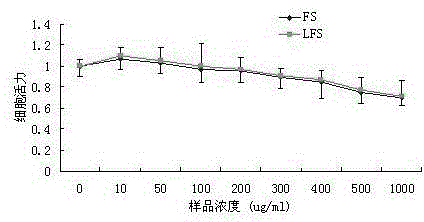Fucoidan sulfate and application of low-molecular-weight fucoidan sulfate in preparation of metabolic syndrome resistant medicines and health products
A fucoidan sulfate, low molecular weight technology, applied in the field of medicine, can solve the problems such as no application report of fucoidan sulfate
- Summary
- Abstract
- Description
- Claims
- Application Information
AI Technical Summary
Problems solved by technology
Method used
Image
Examples
Embodiment 1
[0026] The preparation method of fucoidan sulfate ester of the present invention comprises the following steps:
[0027] (1) Put the brown algae powder in an organic solvent such as methanol, acetone or ethanol with a mass ratio of 80%, soak each time at 80°C for 3 hours, repeat 3 times, to degrease by soaking;
[0028] The brown algae is taken from one or more of Fucus, Ascophyllum nodosum, Sargasso, Undaria pinnatifida, Hijiki, Sage, sea millet, kelp or kelp, among which Fucus is preferred.
[0029] (2) Extract with water at 80°C, then precipitate with ethanol with a mass ratio of 80%, and then dry at 40°C to obtain crude fucoidan sulfate;
[0030] (3) Then in CaCl 2 or MgCl 2 Precipitation with 20% ethanol in the presence of water-soluble alginate;
[0031] (4) Dialysis, concentration, precipitation with 80% ethanol by mass ratio, and drying at 40° C. to obtain purified fucoidan sulfate. The prepared fucoidan sulfate has a molecular weight of 200kD-2000kD (both values ...
Embodiment 2
[0033] Example 2 Cytotoxicity detection of fucoidan sulfate (FS) and low molecular weight fucoidan sulfate (LFS).
[0034] The present invention adopts a classic cell model of metabolic syndrome, and evaluates the effect of the fucoidan sulfate on improving insulin resistance and anti-metabolic syndrome through experiments. Experimental results such as figure 1 As shown, fucoidan sulfate (FS) and low molecular weight fucoidan sulfate (LFS) have no obvious toxicity to cells in the range of 0-400 μg / mL, and when the concentration reaches 500 μg / mL and above, showed some cytotoxicity. However, the highest experimental concentration of the present invention is 100 μg / mL, so it will not produce any toxicity to cells.
Embodiment 3
[0035] Example 3 Fucoidan sulfate (FS) and low molecular weight fucoidan sulfate (LFS) inhibit the gluconeogenesis pathway of hepatocytes, increase glycogen synthesis, and improve insulin resistance.
[0036] The inhibitory effect of FS and LFS on the gluconeogenesis pathway of hepatocytes was evaluated by using the cell model established by the human hepatocyte line HepG2 exposed to high glucose and insulin-containing medium. Metformin was selected as the positive drug.
[0037] The experimental results are shown in Table 1. FS and LFS can significantly inhibit the gluconeogenesis level of liver cells and increase the amount of glycogen synthesis. The Western blot results in Table 2 also show that FS and LFS can significantly up-regulate insulin as shown in Table 2. Phosphorylation of IRS-2, Akt, GSK-3 in the signal transduction pathway, inhibits the expression of G6Pase. It was proved that FS and LFS can improve insulin resistance by specifically activating IRS-2 / PI3K signa...
PUM
| Property | Measurement | Unit |
|---|---|---|
| Molecular weight | aaaaa | aaaaa |
| Molecular weight | aaaaa | aaaaa |
Abstract
Description
Claims
Application Information
 Login to View More
Login to View More - R&D
- Intellectual Property
- Life Sciences
- Materials
- Tech Scout
- Unparalleled Data Quality
- Higher Quality Content
- 60% Fewer Hallucinations
Browse by: Latest US Patents, China's latest patents, Technical Efficacy Thesaurus, Application Domain, Technology Topic, Popular Technical Reports.
© 2025 PatSnap. All rights reserved.Legal|Privacy policy|Modern Slavery Act Transparency Statement|Sitemap|About US| Contact US: help@patsnap.com



